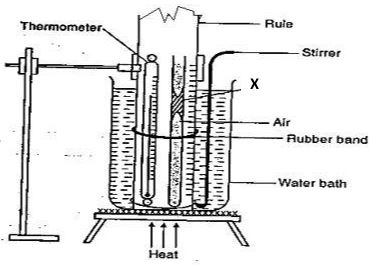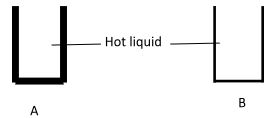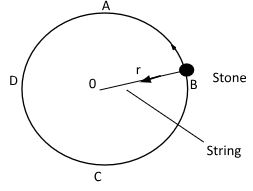- Answer all the questions in sections A and B in the spaces provided.
- All workings must be clearly shown.
- Mathematical tables and non-programmable silent electronic calculators may be used.
- Candidates should answer the questions in English
SECTION A (25 MARKS)
- State the procedure followed when using a metre rule (3mks)
- Define a compression force. (1mk)
- Mosquito larvae floats on water surface. Explain how oiling controls the breeding of mosquitoes. (1mk)
- Complete the table below (3mks)
Equilibrium state Effect of external force on position of centre of gravity Stable Unstable Neutral - A model toy boat of cross-sectional area 1000 cm2 floats in fresh water. If the boat sinks 6cm as a result of loading, calculate the load on the boat. Given that the density of water is 1g/cm3 (3mks)
- The type of the material is one factor which affects spring constant. State other two factors. (2mks)
- Water with negligible viscosity flows steadily through a horizontal pipe of varying cross-sectional area. At a point A of area 10cm2, the velocity is 0.2m/s. Calculate the pressure difference between A and B. If the area at B is 2.5cm2 and density of water is 1000kg/m3. (3mks)
- State the principle of moments. (1mk)
- Draw a sketch of displacement time graph for a body moving with decreasing velocity. (2mks)
- Define the term velocity ratio as used in machines. (1mk)
- The diagram below shows a block being dragged on a horizontal floor. If the coefficient of kinetic friction is 0.40, determine force F required to move the box at uniform speed. (3mks)
- State the part of the vacuum flask which minimizes heat loss by (2mks)
- Radiation
- Conduction
SECTION B (55 MARKS)
-
- Define pressure and state its SI unit (2mks)
- Show that the pressure exerted by a fluid is given by the formula. P = hρg. Where h is the height of the fluid, ρ is the density of the fluid and g is the acceleration due to gravity. (3mks)
- The figure below shows a U-tube manometer containing air, mercury and water. Calculate the pressure exerted on the trapped air. (Take atmospheric pressure to be 1.05 x 105 pa, density of mercury and water to be 13600kg/m3 and 1000kg/m3 respectively). (3mks)
- Explain why a girl wearing high heeled shoes makes deeper marks while walking on a soft ground than when wearing toughees shoes. (2mks)
- The barometric height at the base of a mountain is 70cmHg. If the mountain is 435.2m high, determine the reading of the mercury barometer at the top of the mountain. Take density of mercury as 13600kg/m3 and that of air as 1.25kg/m3. (3mks)
-
- State Pressure Law (1mk)
- The following diagram shows a set-up of apparatus used to verify Charles Law.
- Give the name of part labelled X (1mk)
- State the component of X (1mk)
- State two functions of the part named in (i) above? (2mks)
- Briefly explain how the set up above is used to verify Charles Law (3mks)
- A certain mass of hydrogen gas occupies a volume of 1.6m3 at a pressure of 1.5 x 105Pa and a temperature of 12°c. Determine the volume when the temperature is 0°C at a pressure of 1.0 x 103Pa. (2mks)
-
- Define the term angular velocity. (1mk)
- The diagram below show a stone of mass 500g moving in a vertical circular path of radius 50cm centre O. It is whirled with a frequency of 2 cycles per second.
- Calculate
- Its linear velocity (2mks)
- Tension at A. (3mks)
- Tension at B. (2mks)
- Tension at C. (3mks)
- At what point is the string likely to break? (1mk)
- Indicate the direction of centripetal force on the diagram. (1mk)
- Calculate
-
- Define the term specific heat capacity. (1mk)
- State two precautions to be taken when carrying out the experiment to determine specific heat capacity of solid by electrical method. (2mks)
- A copper calorimeter of mass 0.12kg contains 0.1kg of kerosene at 15°C. If 56g of aluminium at 80°C is transferred into the liquid and the final temperature of the mixture is 27°C. (Taking heat loss to be negligible, specific heat capacity of aluminium is 900J/kgK and copper 400J/kgK). Determine:
- Heat absorbed by kerosene and calorimeter. (3mks)
- Heat lost by aluminium (2mks)
- The specific heat capacity of kerosene. (2mks)
-
-
- Define the term diffusion (1mk)
- State two factors affecting the rate of diffusion in gases. (2mks)
- Compare liquids and gases in terms of intermolecular forces (1mk)
-
- The diagram below shows a bimetallic strip at room temperature. Draw the strip when temperatures are lowered below room temperature. Given that B has a higher linear expansivity than A. (1mk)
- Explain your answer in b(i) above. (1mk)
- The diagram below shows two glass tumblers filled with boiling water at the same time. State and explain the observation. (3mks)
- The diagram below shows a bimetallic strip at room temperature. Draw the strip when temperatures are lowered below room temperature. Given that B has a higher linear expansivity than A. (1mk)
-
MARKING SCHEME
SECTION A
| 1 | i. Place the metre rule in contact with the object
ii. Place the end of the object against the zero mark on the scale
iii. Position your eye perpendicularly above the scale
|
3mrks | ||||||||
| 2 | A force acting towards an object leading its decrease in size | 1mrk | ||||||||
| 3 | Oil is an impurity, it lowers the surface tension of water and the larvae sinks | 1mrk | ||||||||
| 4 |
|
|||||||||
| 5 |
U = vρg;
= 1000 x 10-6 x 6 x 1000 x 10;
= 60N;
|
3mrks | ||||||||
| 6 |
|
2mrks | ||||||||
| 7 |
A1V1 = A2V2 10 x 0.2 = 2.5 V2 V2 = 0.8 m/s; P = ½ (V1-V2)ρ; = ½ (0.8 – 0.2) x 1000 = 300 Pa; |
3mrks | ||||||||
| 8 | Sum of clockwise moments is equal to sum of anticlockwise moments about the same point
|
1mrk | ||||||||
| 9 |  |
|||||||||
| 10 | The ratio of effort distance to load distance | 1mrk | ||||||||
| 11 | F = µR;
= 0.4 x 50 x 10;
= 200N;
|
3mrk | ||||||||
| 12 | (i). Double silverly walls
(ii). Double glass walls/plastic lid/ rubber pads/plastic casing
|
1mk
1mk
|
||||||||
| SECTION B | ||||||||||
| 13 |
|
2mks
3mks
3mks
2mrks
3mks
|
||||||||
| 14 |
|
1mk
1mk
1mk
2mks
3mks
2mks
|
||||||||
| 15 |
a. It is the rate of change of angular displacement with time b. (i) (I) V = 2πrf; = 2 x 22/7 x 0.5 x 2 = 6.2857m/s; (II) TA = MV2 – mg; T = 0.5 x 6.2857 x 6.2857 – 0.5 x 10; = 34.51N; (III) TB = MV2 ; (IV) TC = MV2 + mg; = 0.5 x 6.2857 x 6.2857 + 0.5 x 10; = 44.51N; (ii) C (iii) |
1mk
2mks
3mks
2mks
3mks
1mk
1mk
|
||||||||
| 16 |
|
1mk
2mks
3mks
2mks
2mks
|
||||||||
| 17 |
|
1mk
2mks
1mk
1mk
1mk
3mks
|
Download Physics Paper 1 Questions and Answers - Lainaku 1 Joint PreMock Exams 2023.
Tap Here to Download for 50/-
Get on WhatsApp for 50/-
Why download?
- ✔ To read offline at any time.
- ✔ To Print at your convenience
- ✔ Share Easily with Friends / Students








